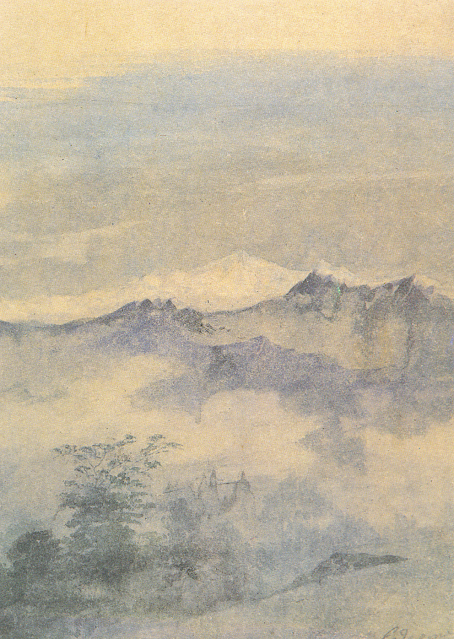The Montagne Sainte Victoire (1, 011m - 2, 216 ft)
France (Provence Alpes Côte d'azur)
In La Sainte Victoire Fusain, 29, x 42cm, 2008.
The artist
Jean-Baptiste Née, born in 1986. is a french painter, scenographer and visual artist, graduated from Arts-Décoratifs of Paris in 2012. Jean-Baptiste Née works in the mountains and high mountains, always in situ, in direct confrontation with the movements of the earth and water and wind. He gives a growing place for the action of the elements on the work in progress (rain, snow, frost, etc.). He established his "large workshop" in the Swiss Alps or in the Vercors massif - especially in winter -, as well as during long hikes in the Italian Alps. In the winter of 2018, he worked in the massifs of Wudangshan and Lushan, in China, and became interested in the Taoist notion of "Sky". Since 2016, Jean-Baptiste Née exhibits regularly in galleries in France and Switzerland. His workshop is in Montreuil, France. Exhibited in Galerie Camera Obscura in Paris. A book was recently published about his work "Le monde nu" Éditions Hartpon. Contact @jeanbaptiste.nee. His new website
The mountain
Mont Sainte-Victoire (1,011 m-3,316ft) also called Mont Venturi is a limestone massif in the South of France, in the region Provence-Alpes-Côte d'Azur. Located east of Aix-en-Provence, it has experienced international fame, due to the more than 80 works Paul Cézanne did on it. It hosts many hikers, climbers and nature lovers, and is a major element of Aix landscape.
The range of the Sainte-Victoire is 18 kilometers long and 5 kilometers from large, following a strict east-west orientation. It is located on the Bouches-du-Rhône and Var, and in the towns of Puyloubier, Saint-Antonin-sur-Bayon, Rousset, Châteauneuf-le-Rouge, Beaurecueil, Le Tholonet Vauvenargues, Saint-Marc-Jaumegarde, Pourrières, Artigues and Rians.
D 10 and D 17 (Route Cézanne) are the main roads to skirt the mountains. On the northern side, the D10 crosses the Col de Claps (530 m) and the Col des Portes (631 m). On the southern side, the D 17 walks on the Plateau de Cengle and crossed the Collet blanc de Subéroque (505 m).
The southern side is characterized by the presence of significant high limestone cliffs 500 to 700 m with the white appearance added to the sun gives the appearance of a high muraille. At the foot of the cliffs, there is more massive brush, oak, kermes oak, Aleppo pine (population greatly reduced after the fire of 1989) but also cultures (olive trees).
On the northern side among the many species present, the Crocus is fairly well represented in the hills and the wild iris and daffodil. One can also see various varieties and boxwood shrubs.
The massif rises to the Pic des Mouches (Peak of the Flies) (1011 m) near the eastern end of the chain, and not at the Croix de Provence (946 m) near the west end and visible from Aix. The Pic des Mouches is one of the highest peaks of the department of Bouches-du-Rhône, behind the peak Bertagne which reached an altitude of 1042 mètres and which is located on the massif of Sainte-Baume.
Sainte-Victoire, as the range of the Sainte Baume, can be considered a special case among the Alpine ranges for the various stages of the formation of its relief associated geological history as well as that of the old Pyrenean-Provençal chain than that of the Western Alps (which have succeeded it).
Indeed, from the former Sainte-Victoire mountain, contemporary of the dinosaurs of the Cretaceous, it remains today only the fold Bimont, said Chaînon des Costes Chaudes, the last vestige resulting from tectonic movements and characteristics of the stacks of Pyreneo-Provençal phase during the Eocene. Later during the Oligocene, breaking of the anticlinal fold of Sainte-Victoire, which resulted from the uplift of the first great Alpine reliefs, is causing a surge that help explain the current form of the mountain, which appeared 15 million years BCE.
Sainte-Victoire, whose calcareous sediments date back to the Jurassic, thus consists of both a Pyrenean-Provencal vestige and of an alpine geology. This singularity and this ambivalence help explain why, although a massive western Alps, the problem of this connection remains complexe.
According to a recent study, the Sainte-Victoire is still growing ! The company ME2i has indeed conducted a satellite survey between 1993 and 2003 providing evidence that during this period the western end of the Sainte-Victoire was uplift of 7 mm per year.
The massif is a ensemble of 6525 ha classified since 1983.
The massive hosts several world-famous dinosaur eggs deposits including the Roques-Hautes / Les Grands-Creux on the town Beaurecueil.
_______________________________
2021 - Wandering Vertexes...
by Francis Rousseau


















